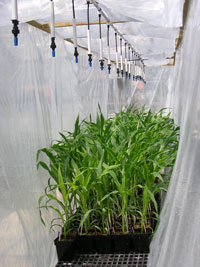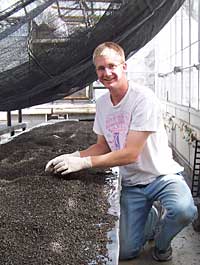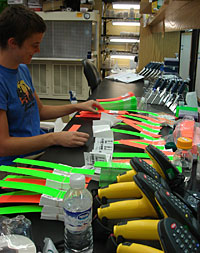Projects
Analysis of the genetic architecture of disease resistance in the cereals.
We analyzed the distributions of quantitative trait loci (QTL) for disease resistance in maize and rice, and found that QTL for multiple diseases were clustered in the genomes of both crops (Wisser et al., 2005; Wisser et al., 2006). This led us to the hypothesis that genes or gene clusters for multiple diseases exist. In the rice genome, we inspected the genes underlying the QTL clusters, looking both at annotation and expression for evidence of a potential role in plant defense. Because the resolution of QTL mapping in the published literature is low, it was not feasible to identify compelling positional candidate genes: there are simply too many candidates! We have thus focused on genetic dissection of QTL in subsequent studies.
Development of near-isogenic lines for quantitative trait loci conditioning reduced susceptibility.
We have identified a variety of sources of disease resistance, some of which are known to possess resistance to multiple diseases. We are using a range of methods to extract near-isogenic lines (NILs) in which QTL of interest are present or absent in a given genetic background. We are using these lines to learn about the mechanisms of resistance conditioned by the QTL. The NILs are also useful as we proceed towards cloning of the QTL. One of the QTL identified in NILs provides resistance to three different vascular diseases (northern leaf blight, anthracnose stalk rot and Stewart’s wilt). For details, see the Abstract and Posters.
Nested association mapping (NAM) and association mapping.
We have mapped disease QTL in “the ultimate germplasm resource to date for localizing QTLs in maize,” developed by Ed Buckler et al. (http://www.maizegenetics.net/). Using this large mapping population, we have identified QTL for resistance to northern leaf blight with unprecedented resolution. By combining information on linkage with information from the association mapping panel also developed by Buckler and colleagues, we are able to test candidate genes for association with disease and other phenotypes. For several of the QTL mapped in the NAM population, we have validated the QTL in near-isogenic lines (see above). In collaboration with the lab of Peter Balint-Kurti at North Carolina State University, we have obtained disease-related phenotypes for the association mapping panel mentioned above for three diseases. We are using the data to identify genes that provide resistance to one, two and three diseases. We will continue using these mapping resources to identify genes important for disease management in the US and Kenya. For details see the Abstract and Poster.
Selection mapping of genes conditioning disease resistance.
We have analyzed QTL for disease resistance using an approach called selection mapping (SM), in which QTL are identified by comparing the allele frequencies of loci before and after recurrent selection for a trait of interest. The trick is to distinguish shifts in allele frequency that can be attributed to selection from those that occur as a result of genetic drift. To achieve this, we developed an improved test statistic and used it for selection mapping in several maize populations developed by the International Maize and Wheat Improvement Center (CIMMYT). Some of the mapped loci have been validated in greenhouse and field studies. See this abstract of a forthcoming manuscript for details and authors. Also see the
Maize Meeting 2008_Abstract.doc
Reducing the vulnerability of maize to aflatoxin accumulation.
Aflatoxin is one of several mycotoxins (fungal metabolites) that cause enormous economic losses and/or health burdens world-wide. Aflatoxin is produced by Aspergillus flavus, a fungus that attacks corn and other foodstuffs. The problem is most acute when plants are stressed by drought and insect attack in the field, and the toxin accumulates further when the crop is stored under sub-optimal conditions. In the US, aflatoxin levels in maize are carefully regulated, causing an economic burden on US growers. In Africa, aflatoxin levels are not regulated, and the toxin is a major health burden. To reduce the problem, we are identifying genes in maize that reduce the efficiency with which the fungus enters the maize ear, and genes that impair growth and toxin production in the host. See attached abstract for details.
Population biology of the gray leaf spot pathogens of maize in NY state.
It is important to understand fungal populations for various reasons, including the need to understand how host defense genes respond to the existing pathogen diversity. We conducted a survey of the gray leaf spot (GLS) pathogens in New York, to better understand the prevalence and distribution of the two known Cercospora species causing GLS. Both species were found in the state, often in the same fields. See the linked abstract for details and authorship.
Mechanisms of quantitative resistance
Studies on host-pathogen interactions in a range of pathosystems have revealed an array of mechanisms by which plants reduce the efficiency of pathogenesis. With the ability to map disease QTLs and transfer them to NILs, it is possible to address the question of whether disease QTLs affect different stages of pathogenesis. We developed and applied a series of microscopic parameters to investigate host-pathogen interactions as influenced by QTLs for resistance to northern leaf blight. Our preliminary results comparing two NLB-QTLs suggest that one (designated qEt1.06B73) reduces penetration of the pathogen into the leaf, while the other (designated qEt1.02Tx303) reduces the efficiency with which the pathogen enters the xylem from its initial mesophyllic colony. We expect that pyramiding favorable alleles of QTLs with distinct mechanisms of resistance against fungal penetration and colonization would be more effective than combining loci with redundant effects. For details, see the linked abstract and poster (PDF) .
Claymation.
We use claymation to illustrate the host-pathogen interactions that are potentially related to quantitative disease resistance. It helps us mentally deconstruct the process, identifying the steps that have been found in various pathosystems in the literature. This helps us visualize our hypotheses. See a PDF of our claymation.

Mister setup in the greenhouse for inoculation experiments.

Jesse Poland drying pathogen-coated sorghum for use as inoculum in our field experiments.

Ellie Walsh preparing bar-coded labels for a field experiment.
